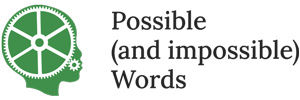
Modesty and caution
Theories and right answers in paediatric speech and language therapy
If you are worried about a child’s speech and / or language, and you probably are or you wouldn’t be here, you quickly encounter a bewildering range of ideas and theories about linguistics and other angles on speech and language tberapy. Obviously, they can’t all be correct. Are they all equally suspect? Is theory just a distraction from the task of remediation? Or is there merit in a cautious evaluation?
My point of departure here is the linguistics which has emerged in the broad framework of what used to be known as ‘Transformational Generative Grammar’, TGG, originally due to Noam Chomsky, now known by many proponents as ‘Biolinguistics’, and by those who disagree with it as a ‘formalism’ or even as an ’empty formalism’. One distinctive character of this approach is to take as data judgements which rely essentially on introspection, to contrast “somebody interesting” or “nothing useful” to “an interesting person” or “a useful article” with the ordering of the words depending on whether one of them is what is known a pronoun, like somebody or nothing. These orderings contrast with “interesting somebody” and “an article useful”, which are for me, almost uninterpretable as simple phrases. But no variety of formalism or TGG or biolinguistics is commonly adopted in discussion of children’s speech and language. Commonly, in the discussion of children’s speech and language, there is a preference for approaches by which introspective data are just not data, no matter how robustly they are shared across native speakers. There is, I believe, no good reason for dismissing out of hand reasoning which depends, in the last analysis, on common knowledge, as one way of looking into human minds.
But as far as I am concerned, biolinguistics is just a point of departure. There are other perspectives, some very hostile to biolinguistics, looking at language as a distinctive aspect of human society, some describing themselves as ‘functionalist’ or ‘constructivist’. Ignoring the hostilities, it seems to me more useful just to take account of all the evidence. Some of this evidence is taken directely from the many and various problems which some children have in learning to talk.
In my view, theories of all sorts should be proposed with a degree of modesty, humility, and caution. I try to do so here. But I see no merit in not taking sides where there is a clear conflict, as there is between those who believe that linguistic structures are GENERATED and those who prefer to see language as BEHAVIOUR. As far as I am concerned, theories which seek to reduce language to behaviour just miss whatever it is that makes language the stuff of love, hope, legend, invention, science, comedy, and law. Without syntax at least, there would be no such thing as human society.
In my view, especially where children are involved, it is appropriate to be cautious and to take stock of the weight of the evidence. I try to do this in my proposal here which I have been working on since Nunes (2002). Plainly and rather obviously, speech and language have evolved as one of the distinguishing characters of the human species. By my proposal here, this evolution probably began some time before modern human ancestors diverged from Neanderthal ancestors about 650,000 years ago, involved at least seven steps, and was completed by around 135,000 years ago, according to Shigeru Miyagawa and others (2025). Each step must have taken tens or hundreds of thousands of years to disperse through the ancestral human population, contributing one by one to what most proponents of TGG or biolinguistics regard as ‘Universal Grammar’, or the linguistically specific aspects of the modern human genome. This applies no matter how much general cognition has contributed to the process.

